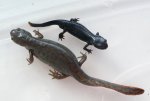Jesper
New member
Hey,
I have been raising a bunch of orientalis of different sizes, and I have followed a couple of males with greyish color.... They have this red dorsal stripe with black dots along the stripe. Ive handled quite of lot of orientalis over the last 2 decades and I never saw grey ones(except photos ofc} until I came over to the UK from Sweden, Ive seen some pics of greyish orientalis with what seems like a red dorsal stripe but it is hard to tell. I would like to know how common these are(grey colour with and without stripe} and if both genders have these stripes.
Nate got me interested in this back in the day...
I have been raising a bunch of orientalis of different sizes, and I have followed a couple of males with greyish color.... They have this red dorsal stripe with black dots along the stripe. Ive handled quite of lot of orientalis over the last 2 decades and I never saw grey ones(except photos ofc} until I came over to the UK from Sweden, Ive seen some pics of greyish orientalis with what seems like a red dorsal stripe but it is hard to tell. I would like to know how common these are(grey colour with and without stripe} and if both genders have these stripes.
Nate got me interested in this back in the day...

